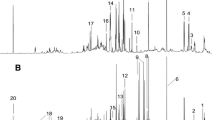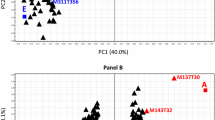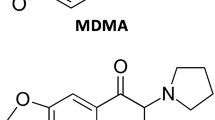Abstract
Endosulfan is the newly persistent organic pollutants (POPs) added to the Stockholm Convention as its widespread use, persistence, bioaccumulation, long-range transport, endocrine disruption, and toxicity related to various adverse effects. In the present study, male mice were administrated endosulfan at 0, 0.5, and 3.5 mg/kg by gavage for 2 weeks. 1H-NMR-based urinary metabolomics, HPLC-MS/MS-based targeted serum metabolomics, clinical analysis, and histopathology techniques were employed to evaluate the metabolic perturbations of subacute endosulfan exposure. Endosulfan exposures resulted in weight loss, liver inflammation and necrosis, and alterations in serum amino acids and urine metabolomics. Based on altered metabolites, several significantly perturbed pathways were identified including glycine, serine, and threonine metabolism; TCA cycle; pyruvate metabolism; glycolysis or gluconeogenesis; glycerophospholipid metabolism; and glyoxylate and dicarboxylate metabolism. Such pathways were highly related to amino acid metabolism, energy metabolism, and lipid metabolism. In addition, metabolomic results also demonstrated that gut microbiota was remarkably altered after endosulfan exposure. These observations may provide novel insight into revealing the potential toxic mechanism and evaluating the health risk of endosulfan exposure at metabolomic level.






Similar content being viewed by others
References
Al Rajabi A et al (2014) Choline supplementation protects against liver damage by normalizing cholesterol metabolism in Pemt/Ldlr knockout mice fed a high-fat diet. J Nutr 144:252–257. doi:10.3945/jn.113.185389
Aliferis KA, Chrysayi-Tokousbalides M (2011) Metabolomics in pesticide research and development: review and future perspectives. Metabolomics 7:35–53. doi:10.1007/s11306-010-0231-x
Amelio I, Cutruzzola F, Antonov A, Agostini M, Melino G (2014) Serine and glycine metabolism in cancer. Trends Biochem Sci 39:191–198. doi:10.1016/j.tibs.2014.02.004
An Y et al (2013) High-fat diet induces dynamic metabolic alterations in multiple biological matrices of rats. J Proteome Res 12:3755–3768. doi:10.1021/pr400398b
Becker L, Scheringer M, Schenker U, Hungerbuhler K (2011) Assessment of the environmental persistence and long-range transport of endosulfan. Environ Pollut 159:1737–1743. doi:10.1016/j.envpol.2011.02.012
Berntssen MH, Glover CN, Robb DH, Jakobsen JV, Petri D (2008) Accumulation and elimination kinetics of dietary endosulfan in Atlantic salmon (Salmo salar). Aquat Toxicol 86:104–111. doi:10.1016/j.aquatox.2007.10.006
Bollard ME et al (2010) NMR-based metabolic profiling identifies biomarkers of liver regeneration following partial hepatectomy in the rat. J Proteome Res 9:59–69. doi:10.1021/pr900200v
Brunelli E, Bernabo I, Berg C, Lundstedt-Enkel K, Bonacci A, Tripepi S (2009) Environmentally relevant concentrations of endosulfan impair development, metamorphosis and behaviour in Bufo bufo tadpoles. Aquat Toxicol 91:135–142. doi:10.1016/j.aquatox.2008.09.006
Bundy JG, Davey MP, Viant MR (2009) Environmental metabolomics: a critical review and future perspectives. Metabolomics 5:3–21. doi:10.1007/s11306-008-0152-0
Dong F, Zhang L, Hao F, Tang H, Wang Y (2013) Systemic responses of mice to dextran sulfate sodium-induced acute ulcerative colitis using 1H NMR spectroscopy. J Proteome Res 12:2958–2966. doi:10.1021/pr4002383
Dorval J, Leblond VS, Hontela A (2003) Oxidative stress and loss of cortisol secretion in adrenocortical cells of rainbow trout (Oncorhynchus mykiss) exposed in vitro to endosulfan, an organochlorine pesticide. Aquat Toxicol 63:229–241. doi:10.1016/s0166-445x(02)00182-0
Du H et al (2015a) Endosulfan isomers and sulfate metabolite induced reproductive toxicity in Caenorhabditis elegans involves genotoxic response genes. Environ Sci Technol 49:2460–2468. doi:10.1021/es504837z
Du H et al (2015b) Reproductive toxicity of endosulfan: implication from germ cell apoptosis modulated by mitochondrial dysfunction and genotoxic response genes in Caenorhabditis elegans. Toxicol Sci 145:118–127. doi:10.1093/toxsci/kfv035
Favre D et al (2010) Tryptophan catabolism by indoleamine 2,3-dioxygenase 1 alters the balance of TH17 to regulatory T cells in HIV disease. Sci Transl Med 2:32ra36. doi:10.1126/scitranslmed.3000632
Gao Y et al (2014) Identifying early urinary metabolic changes with long-term environmental exposure to cadmium by mass-spectrometry-based metabolomics. Environ Sci Technol 48:6409–6418. doi:10.1021/es500750w
Guo FZ et al (2016) Endosulfan inhibiting the meiosis process via depressing expressions of regulatory factors and causing cell cycle arrest in spermatogenic cells. Environ Sci Pollut Res Int 23:20506–20516. doi:10.1007/s11356-016-7195-y
Hiruma K et al (2013) Glutathione and tryptophan metabolism are required for Arabidopsis immunity during the hypersensitive response to hemibiotrophs. Proc Natl Acad Sci U S A 110:9589–9594. doi:10.1073/pnas.1305745110
Jia H et al (2010) Monitoring and modeling endosulfan in Chinese surface soil. Environ Sci Technol 44:9279–9284. doi:10.1021/es102791n
Jobgen WS, Fried SK, Fu WJ, Meininger CJ, Wu G (2006) Regulatory role for the arginine-nitric oxide pathway in metabolism of energy substrates. J Nutr Biochem 17:571–588. doi:10.1016/j.jnutbio.2005.12.001
Kalender S, Kalender Y, Ogutcu A, Uzunhisarcikli M, Durak D, Acikgoz F (2004) Endosulfan-induced cardiotoxicity and free radical metabolism in rats: the protective effect of vitamin E. Toxicology 202:227–235. doi:10.1016/j.tox.2004.05.010
Kaspar H (2009) Amino acid analysis in biological fluids by GC-MS. Dissertation, University of Regensburg
Kohlmeier M, da Costa KA, Fischer LM, Zeisel SH (2005) Genetic variation of folate-mediated one-carbon transfer pathway predicts susceptibility to choline deficiency in humans. Proc Natl Acad Sci U S A 102:16025–16030. doi:10.1073/pnas.0504285102
Landfried K et al (2011) Tryptophan catabolism is associated with acute GVHD after human allogeneic stem cell transplantation and indicates activation of indoleamine 2,3-dioxygenase. Blood 118:6971–6974. doi:10.1182/blood-2011-06-357814
Li YF, Macdonald RW (2005) Sources and pathways of selected organochlorine pesticides to the Arctic and the effect of pathway divergence on HCH trends in biota: a review. Sci Total Environ 342:87–106. doi:10.1016/j.scitotenv.2004.12.027
Li Z, Agellon LB, Vance DE (2005) Phosphatidylcholine homeostasis and liver failure. J Biol Chem 280:37798–37802. doi:10.1074/jbc.M508575200
Li H, An Y, Zhang L, Lei H, Wang Y, Tang H (2013) Combined NMR and GC-MS analyses revealed dynamic metabolic changes associated with the carrageenan-induced rat pleurisy. J Proteome Res 12:5520–5534. doi:10.1021/pr400440d
Lu Y, Morimoto K, Takeshita T, Takeuchi T, Saito T (2000) Genotoxic effects of alpha-endosulfan and beta-endosulfan on human HepG2 cells. Environ Health Perspect 108:559–561. doi:10.2307/3454619
Machala M et al (2004) Toxicity of hydroxylated and quinoid PCB metabolites: inhibition of gap junctional intercellular communication and activation of aryl hydrocarbon and estrogen receptors in hepatic and mammary cells. Chem Res Toxicol 17:340–347. doi:10.1021/tx030034v
Mannick JB (2007) Regulation of apoptosis by protein S-nitrosylation. Amino Acids 32:523–526. doi:10.1007/s00726-006-0427-6
Marc Rhoads J, Wu G (2009) Glutamine, arginine, and leucine signaling in the intestine. Amino Acids 37:111–122. doi:10.1007/s00726-008-0225-4
McCombie G, Browning LM, Titman CM, Song M, Shockcor J, Jebb SA, Griffin JL (2009) Omega-3 oil intake during weight loss in obese women results in remodelling of plasma triglyceride and fatty acids metabolomics. Metabolomics 5:363–374. doi:10.1007/s11306-009-0161-7
Mehrmohamadi M, Liu X, Shestov AA, Locasale JW (2014) Characterization of the usage of the serine metabolic network in human cancer. Cell Rep 9:1507–1519. doi:10.1016/j.celrep.2014.10.026
Meijer AJ (2003) Amino acids as regulators and components of nonproteinogenic pathways. J Nutr 133:2057S–2062S
Noel M, Loseto LL, Helbing CC, Veldhoen N, Dangerfield NJ, Ross PS (2014) PCBs are associated with altered gene transcript profiles in arctic beluga whales (Delphinapterus leucas). Environ Sci Technol 48:2942–2951. doi:10.1021/es403217r
Nomiyama K et al (2014) Toxicological assessment of polychlorinated biphenyls and their metabolites in the liver of Baikal seal (Pusa sibirica). Environ Sci Technol 48:13530–13539. doi:10.1021/es5043386
Pereira VM et al (2012) Endosulfan exposure inhibits brain AChE activity and impairs swimming performance in adult zebrafish (Danio rerio). Neurotoxicology 33:469–475. doi:10.1016/j.neuro.2012.03.005
Quinete N, Castro J, Fernandez A, Zamora-Ley IM, Rand GM, Gardinali PR (2013) Occurrence and distribution of endosulfan in water, sediment, and fish tissue: an ecological assessment of protected lands in south Florida. J Agric Food Chem 61:11881–11892. doi:10.1021/jf403140z
Schmidt WF et al (2014) Temperature-dependent Raman spectroscopic evidence of and molecular mechanism for irreversible isomerization of beta-endosulfan to alpha-endosulfan. J Agric Food Chem 62:2023–2030. doi:10.1021/jf404404w
Shao B et al (2012) DNA damage and oxidative stress induced by endosulfan exposure in zebrafish (Danio rerio). Ecotoxicology 21:1533–1540. doi:10.1007/s10646-012-0907-2
Shi X et al (2012) Metabolomic analysis of the effects of polychlorinated biphenyls in nonalcoholic fatty liver disease. J Proteome Res 11:3805–3815. doi:10.1021/pr300297z
Silva MH, Beauvais SL (2010) Human health risk assessment of endosulfan. I: Toxicology and hazard identification. Regul Toxicol Pharmacol: RTP 56:4–17. doi:10.1016/j.yrtph.2009.08.013
Sohn HY, Kwon CS, Kwon GS, Lee JB, Kim E (2004) Induction of oxidative stress by endosulfan and protective effect of lipid-soluble antioxidants against endosulfan-induced oxidative damage. Toxicol Lett 151:357–365. doi:10.1016/j.toxlet.2004.03.004
Song X et al (2015) Polychlorinated biphenyl quinone metabolite promotes p53-dependent DNA damage checkpoint activation, S-phase cycle arrest and extrinsic apoptosis in human liver hepatocellular carcinoma HepG2 cells. Chem Res Toxicol. doi:10.1021/acs.chemrestox.5b00320
Stanley KA, Curtis LR, Simonich SL, Tanguay RL (2009) Endosulfan I and endosulfan sulfate disrupts zebrafish embryonic development. Aquat Toxicol 95:355–361. doi:10.1016/j.aquatox.2009.10.008
Trousil S et al (2014) Alterations of choline phospholipid metabolism in endometrial cancer are caused by choline kinase alpha overexpression and a hyperactivated deacylation pathway. Cancer Res 74:6867–6877. doi:10.1158/0008-5472.can-13-2409
Tyagi R et al (2012) Urinary metabolomic phenotyping of nickel induced acute toxicity in rat: an NMR spectroscopy approach. Metabolomics 8:940–950. doi:10.1007/s11306-011-0390-4
Uboh FE, Asuquo EN, Eteng MU (2011) Endosulfan-induced hepatotoxicity is route of exposure independent in rats. Toxicol Ind Health 27:483–488. doi:10.1177/0748233710387011
van der Goot AT et al (2012) Delaying aging and the aging-associated decline in protein homeostasis by inhibition of tryptophan degradation. Proc Natl Acad Sci U S A 109:14912–14917. doi:10.1073/pnas.1203083109
Wang LF et al (2012) Application of 1H-NMR-based metabolomics for detecting injury induced by long-term microwave exposure in Wistar rats’ urine. Anal Bioanal Chem 404:69–78. doi:10.1007/s00216-012-6115-3
Weber J et al (2010) Endosulfan, a global pesticide: a review of its fate in the environment and occurrence in the Arctic. Sci Total Environ 408:2966–2984. doi:10.1016/j.scitotenv.2009.10.077
Wu G (2009) Amino acids: metabolism, functions, and nutrition. Amino Acids 37:1–17. doi:10.1007/s00726-009-0269-0
Wu G, Fang YZ, Yang S, Lupton JR, Turner ND (2004) Glutathione metabolism and its implications for health. J Nutr 134:489–492
Xu J, Jiang H, Li J, Cheng KK, Dong J, Chen Z (2015) 1H NMR-based metabolomics investigation of copper-laden rat: a model of Wilson’s disease. PLoS One 10:e0119654. doi:10.1371/journal.pone.0119654
Yuk J, Simpson MJ, Simpson AJ (2013) 1-D and 2-D NMR-based metabolomics of earthworms exposed to endosulfan and endosulfan sulfate in soil. Environ Pollut 175:35–44. doi:10.1016/j.envpol.2012.12.007
Zeisel SH (2011) Nutritional genomics: defining the dietary requirement and effects of choline. J Nutr 141:531–534. doi:10.3945/jn.110.130369
Zhang L, Ye Y, An Y, Tian Y, Wang Y, Tang H (2011) Systems responses of rats to aflatoxin B1 exposure revealed with metabonomic changes in multiple biological matrices. J Proteome Res 10:614–623. doi:10.1021/pr100792q
Zhang Y, Zhang Z, Zhao Y, Cheng S, Ren H (2013) Identifying health effects of exposure to trichloroacetamide using transcriptomics and metabonomics in mice (Mus musculus). Environ Sci Technol 47:2918–2924. doi:10.1021/es3048976
Zhang L et al (2014) Metabonomic analysis reveals efficient ameliorating effects of acupoint stimulations on the menopause-caused alterations in mammalian metabolism. Sci Rep 4:3641. doi:10.1038/srep03641
Zhang L et al (2015a) Metabolomics reveals that aryl hydrocarbon receptor activation by environmental chemicals induces systemic metabolic dysfunction in mice. Environ Sci Technol 49:8067–8077. doi:10.1021/acs.est.5b01389
Zhang Y, Zhao F, Deng Y, Zhao Y, Ren H (2015b) Metagenomic and metabolomic analysis of the toxic effects of trichloroacetamide-induced gut microbiome and urine metabolome perturbations in mice. J Proteome Res 14:1752–1761. doi:10.1021/pr5011263
Zhu W et al (2011) Quantitative profiling of tryptophan metabolites in serum, urine, and cell culture supernatants by liquid chromatography-tandem mass spectrometry. Anal Bioanal Chem 401:3249–3261. doi:10.1007/s00216-011-5436-y
Zhu J, Wu Y, Tang Q, Leng Y, Cai W (2014) The effects of choline on hepatic lipid metabolism, mitochondrial function and antioxidative status in human hepatic C3A cells exposed to excessive energy substrates. Nutrients 6:2552–2571. doi:10.3390/nu6072552
Acknowledgements
This study was financially supported by the National Natural Science Foundation of China (21207158, 21337005).
Author information
Authors and Affiliations
Corresponding author
Ethics declarations
Conflict of interest
The authors declare that they have no conflict of interest.
Additional information
Responsible editor: Philippe Garrigues
Electronic supplementary material
ESM 1
(DOCX 1351 kb).
Rights and permissions
About this article
Cite this article
Zhang, P., Zhu, W., Wang, D. et al. A combined NMR- and HPLC-MS/MS-based metabolomics to evaluate the metabolic perturbations and subacute toxic effects of endosulfan on mice. Environ Sci Pollut Res 24, 18870–18880 (2017). https://doi.org/10.1007/s11356-017-9534-z
Received:
Accepted:
Published:
Issue Date:
DOI: https://doi.org/10.1007/s11356-017-9534-z




